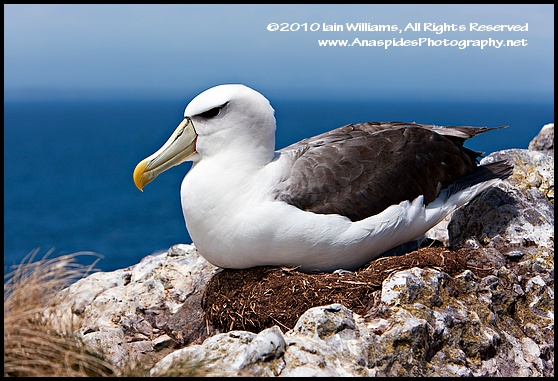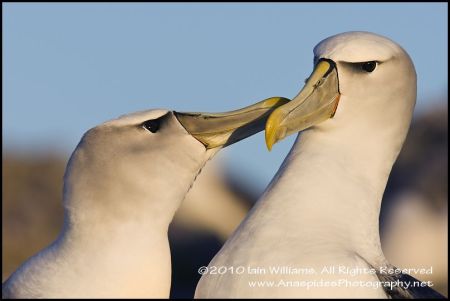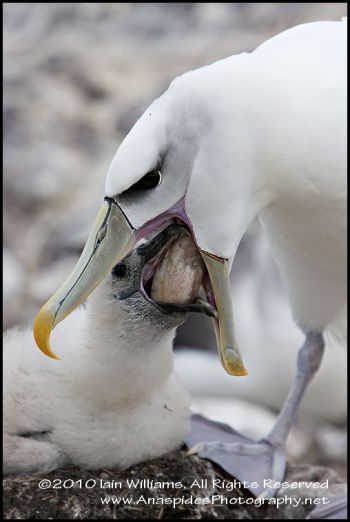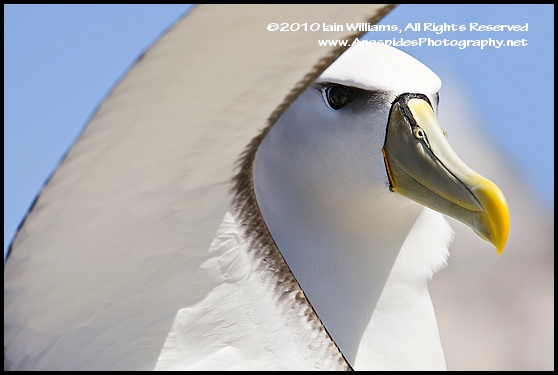Tasmanian Seabirds Field Trip - Albatross; Post 2
 Sunday, February 14, 2010 at 9:59PM
Sunday, February 14, 2010 at 9:59PM  After establishing base camp it was time to explore our new home. As already mentioned, the whole island is made from “roughly” fist sized pieces of conglomerate (assorted rocks of differing types) cemented together to form rock. The rock doesn’t erode easily, and soil when present is a thin veneer. As such, vegetation is very sparse with grasses growing in soil areas and pink face succulent covering much of the remaining areas. Temperate lichens grow on much of the exposed rock. There are no trees or shrubs. The island has two sea caves formed during the last ice age when sea levels were higher; these caves are separated by a gulch which has formed from the sea and wind erosion of the conglomerate.
After establishing base camp it was time to explore our new home. As already mentioned, the whole island is made from “roughly” fist sized pieces of conglomerate (assorted rocks of differing types) cemented together to form rock. The rock doesn’t erode easily, and soil when present is a thin veneer. As such, vegetation is very sparse with grasses growing in soil areas and pink face succulent covering much of the remaining areas. Temperate lichens grow on much of the exposed rock. There are no trees or shrubs. The island has two sea caves formed during the last ice age when sea levels were higher; these caves are separated by a gulch which has formed from the sea and wind erosion of the conglomerate.
LEFT: Shy Albatross sits on nest above precipitous cliff.
The island is primarily home to Shy Albatross (Thalassarche  cauta), Fairy Prion (Pachyptila turtur), Little Penguin (Eudyptula minor) and Short-tailed Shearwater (Puffinus tenuirostris), although we did observe several other species on the island including Sea Eagles, Little Ravens, Welcome Swallows, Australasian Gannets and introduced Starlings.
cauta), Fairy Prion (Pachyptila turtur), Little Penguin (Eudyptula minor) and Short-tailed Shearwater (Puffinus tenuirostris), although we did observe several other species on the island including Sea Eagles, Little Ravens, Welcome Swallows, Australasian Gannets and introduced Starlings.
LEFT: Male and Female Shy Albatross "beak clack" and lean into each other when reuniting after a day at sea.
The Shy Albatross use a number of breeding rookeries at the highest point on the island adjacent to steep cliffs. Every day, Rebecca and I would traverse a narrow ledge that lead its way from the sea cave to the top of the island, to observe the albatross at the rookeries. The shys are one of the larger species in the albatross family and have an incredible wingspan of ~256 cm (~101 inches) and  weigh approximately 4.4 kilograms (9.7 pounds). To see these beautiful birds at close quarters is a tantalising experience and you realize their immense size when seen in association with smaller gannets and ravens.
weigh approximately 4.4 kilograms (9.7 pounds). To see these beautiful birds at close quarters is a tantalising experience and you realize their immense size when seen in association with smaller gannets and ravens.
LEFT: Shy Albatross feeds chick a diet of Arrow Squid caught at sea. Feeding time is usually in the early evening. Both the female and the male parent share in flying to sea to find food for the fast-growing youngster. Food is always regurgitated after furious squawking and beak tapping from the baby.
The breeding season was well developed by January and although many youngsters had fledged, many were still on their nests waiting to be fed a diet a squid, captured at sea by both the male and female parents. It was interesting to observe that the nests of the shy are comprised of soil and bone which is held together by the bird’s regurgitation (cement). Despite the lack of initial breeding courtship display, it was fascinating to observe how either the male or female bird when returning to the nest would initiate a quick and furious beak clacking ritual to renegotiate the bond that these birds have with each other (for the most part albatross are monogamous and breed with the same partner for life) .
Shys (and many other seabirds) inhabit offshore islands for a reason, other than solitude and lack of terrestrial predators – WIND. Large seabirds need wind and/or steep cliffs to launch themselves airborne. In the time we were on the island, the wind didn’t cease blowing once – and the birds loved it. Every morning and evening (and during the day to some extent) the birds would glide and ride the updrafts, thermals and wind breaks. Often they would swoop so close to us you could hear the wind noise as their large wings cut through the

air.
Of vital importance (to Rebecca and myself) was the ongoing safety and health of the shys. Albatross chicks rely very much on their parents for survival. They derive their nourishment including water from the supply of squid fed to them; the chicks do not drink. If an albatross chick is approached too closely it will regurgitate its stomach in an attempt to scare you (you’re an unknown predator to them).
LEFT: Shy Albatross glides graciously on updrafts. The wind span of these birds is immense and it's easy to understand that alabtross are made for flying.
This regurgitation can dehydrate a chick to the point of death, especially if  daytime temperatures are severe. Further, the heart rate of the Shy Albatross can increase dramatically when a person approaches too close, although this is not evident in the bird’s behaviour. Therefore, we used 500, 400 and 300mm lenses for the most part to maintain a safe distance from the parents and chicks. On occasions when the birds were flying close to us, we used 70-200mm zoom lenses with a 1.4 tele extender.
daytime temperatures are severe. Further, the heart rate of the Shy Albatross can increase dramatically when a person approaches too close, although this is not evident in the bird’s behaviour. Therefore, we used 500, 400 and 300mm lenses for the most part to maintain a safe distance from the parents and chicks. On occasions when the birds were flying close to us, we used 70-200mm zoom lenses with a 1.4 tele extender.
LEFT: Wings raised ready for take off, the albatross is one of the most magestic birds of the animal kingdom.
More to follow soon on this amazing trip.
Shy Albatross HD video to follow soon.....



Reader Comments